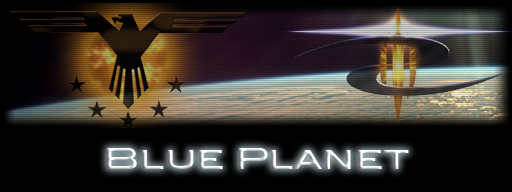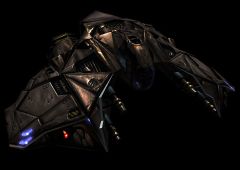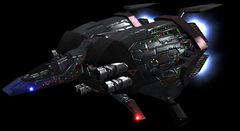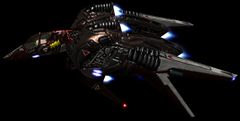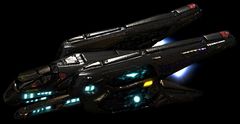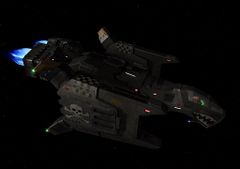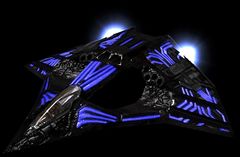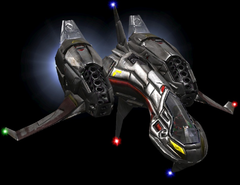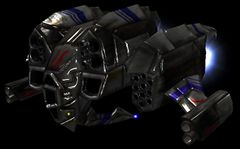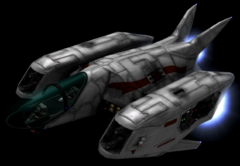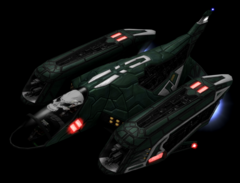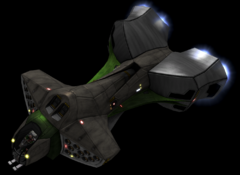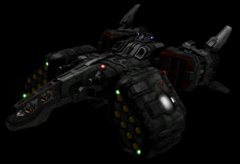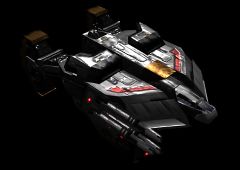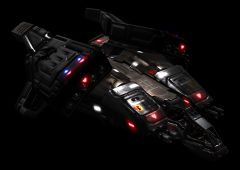Blue Planet Extras Portal
This page lists tech room entries present in Blue Planet for reference and ease of access, as many of those do not belong anywhere else (BP descriptions of retail ships, for example, do not belong in their relevant ship pages, as only canon data should be listed there). Also add the possibility to write BP-specific veteran comments for those retail ships and weapons.
Contents
- 1 Ships
- 1.1 GTVA Terran ships
- 1.2 Weapons
- 1.3 Intelligence
- 1.3.1 The Second Incursion
- 1.3.2 The Post-Capella GTVA
- 1.3.3 The Rift, Parts 1 and 2
- 1.3.4 Vasudan Mysticism, Parts 1 and 2
- 1.3.5 Project Nagari, Parts 1 and 2
- 1.3.6 Vishnans and the 14th Battlegroup
- 1.3.7 Vishans: What we know
- 1.3.8 The Reunion, Parts 1 and 2
- 1.3.9 The Balance of Power, Parts 1 to 5
- 1.3.10 The Council of Elders
- 1.3.11 The Fedayeen
- 1.3.12 Admiral Anita Lopez
- 1.3.13 Admiral Cyrus Severanti
- 1.3.14 Admiral Chiwitel Steele
- 1.3.15 Admiral Robert Byrne
- 1.3.16 Admiral Hans Maxwell "H.M." Calder
- 1.3.17 Unknown Device Schematics (major spoilers)
Ships
GTVA Terran ships
GTF Ulysses
A product of joint Terran-Vasudan design, the Ulysses is a Great War-era light space superiority fighter renowned for its maneuverability and slim target profile. It saw limited action during the Second Shivan Incursion, serving on front-line units with the Neo-Terran Front and as a combat evaluation fighter with the GTVA. The Ulysses remains in very limited production, but has been completely retired from front-line GTVA formations.
GTF Hercules
The Hercules assault fighter was the crowning jewel of Allied fighter forces during the Great War, and it remained a favorite amongst pilots even after the introduction of its successor, the Hercules II. Many Hercules units were lost during the NTF rebellion. The Hercules has been pulled from front-line service, and production has been discontinued. Remaining spaceframes serve as targets or in security operations.
GTF Hercules Mark II
The Hercules II assault fighter sacrifices some of its predecessor's cannon firepower for a boost in secondary capacity. The modernized, hybrid spaceframe offers enhanced ordnance bays and a sophisticated fire control computer. The Hercules II performed well during its OpEval period and, despite casualties during the Second Shivan Incursion, was judged a success in its assigned role attacking lightly defended targets and cruisers. However, the introduction of the Ares spaceframe, a modified Hercules II, has limited Hercules II deployment in the true heavy assault role. Hercules II fighters are used as skirmishers against lightly defended convoys, and as heavy missile pickets on escort missions.
GTF Ares
The Ares was the result of a crash program to rebuild the Hercules Mark 2 as a heavily armored missile boat. Slower and clumsier than its base model, the Ares mounts depleted uranium armor plating over critical subsystems, molybdenum plates, and enhanced shields. It can carry sufficient Trebuchet missiles to disarm a light warship or fend off multiple bomber wings before rearming. The Ares entered service just as the Shivans stormed Capella, and what few units were available saved thousands of lives during escort missions. Despite a stormy production history, the Ares is now a front-line combatant, used in heavy assault missions, pop-up Trebuchet strikes, and critical defensive missions. Despite its usefulness as a missile platform, it cannot dogfight effectively, and must avoid interceptors at all costs.
GTF Erinyes
The Erinyes had barely entered its OpEval period when the Second Shivan incursion began. It served with SOC units and, later, elite line squadrons, where it gained a reputation for massive firepower but low sustainability. Mounting the UD-8 Kayser probability weapon, the Erinyes' eight gun banks and good secondary capability give it tremendous killing power. But its reactor cannot handle the strain of sustained fire, and its maneuverability leaves something to be desired. Although it proved effective at massacring most Shivan fighters, and went into wide-scale production during the Threat Exigency Initiative, it remains an oddly paradoxical design - an excellent killer but a limited fighter. As agility became more and more critical to fighter design, the complex Erinyes proved impossible to re-engineer. Although it remains in service with elite squadrons for heavy space superiority missions, it will soon be superceded by the next-generation GTF Nyx.
GTF Loki
The linchpin of GTI fighter forces during Rybak's Hades Rebellion was the Loki stealth fighter. Initially an invisible nightmare, the Loki lost its main tactical advantage when a weakness in its stealth systems was discovered. It was moved into the role of scout fighter during Reconstruction, but was often pressed into the dogfight and intercept role by the Neo-Terran Front, where it earned praise for its agility but struggled to compensate for its structural weakness. The Loki has not been produced since the NTF Rebellion, and most remaining spaceframes have been sold off.
GTF Pegasus
The low-visibility, sensor-stealthed Pegasus fighter is a recon platform above all else. Operated primarily by Special Operations Command, Pegasus pilots work in pairs or alone, cruising for long cold hours or days without making telltale subspace jumps. The onboard sensor systems are adequate to the recon task, but limited by the need to maintain EMCON. Even when they must make subspace transits, Pegasus jump drives are difficult to detect or vector. Pegasus pilots gathered critical information that helped suppress brush wars after the Second Incursion, and allegedly performed deniable assassination missions.
GTF Perseus
The mainstay of the Terran fleet after the Second Incursion, the Perseus is produced on nearly every world in the Alliance and assigned to every destroyer in every battle group. Reassigned from intercept to multirole combatant after its sterling performance during the Second Incursion, the Perseus is cheap, flexible, and an excellent dogfighter and interceptor. In a pinch it can perform anti-subsystem strikes on warships with Stiletto II bombs. Even with the advent of next-generation fighters, the Perseus will remain in service for years to come.
GTF Myrmidon
The Myrmidon fighter, designed by RNI Systems to fulfill an impossibly broad request from the Admiralty, is a space superiority fighter with problematic handling, the primary firepower of an assault craft, and three secondary banks of unusual design and limited capacity. It is gradually being phased out, but still serves as a line fighter, bomber escort, and battle group guardian across the Terran elements of the Alliance fleet. Some pilots achieve a particular affinity with this unusual craft, but in general its wide target profile has given it a reputation as a pilot-killer. Captured Neo-Terran Front pilots reported that the Myrmidon was respected for its firepower but considered too clumsy for its role.
GTB Artemis
Artemis bombers were not anticipated to be a success, but after a strong showing during the NTF rebellion, they now represent the majority of the GTVA's tactical strike ability. Maneuverable and cheap, the Artemis is able to deliver its payload rapidly. Tactical analysis suggested that bombers rarely survived prolonged engagement, so the Artemis' limited warhead capacity is considered non-problematic. Without defensive turrets, the Artemis is reliant on fighter escort, but it can dogfight if pressed. This behavior is strongly discouraged during pilot training, but because Artemis bombers are often deployed with inadequate escort, it frequently becomes necessary. The bomber's single primary bank is often fitted with a Maxim cannon for supplementary firepower.
GTB Artemis D.H.
A more maneuverable variant of the Artemis bomber, the Artemis DH has seen production alongside its white-skinned cousin. It is used in the same tactical role, targeting cruisers and corvettes.
GTB Boanerges
A controversial new heavy bomber at the time of the Second Shivan Incursion, the Boanerges proved a logistical dream but a mixed blessing tactically. Heavily shielded and with a large payload, the Boanerges eschewed defensive turrets as "of limited use." Bomber pilots did not react strongly to this decision, and although the Boanerges is at least capable in its role, it still divides pilots today. Good maneuverability allows the Boanerges some success in reaching its targets, but in spite of heavy armor cannot withstand defensive fire from warships or interceptors. It is an open question whether heavy bombers will remain tactically relevant. For the moment, the Boanerges' easy maintenance, cheap assembly, and long lifespan make it common in the heavy anti-shipping and anti-installation role.
GTB Medusa
The Medusa is an obsolete Great War-era bomber. It was used in an anti-shipping role by the Neo-Terran Front, but never met with any real success. GTVA pilots considered the Medusa an ineffective deathtrap.
GTB Ursa
Fifty years after the Great War, the Ursa bomber still serves the GTVA as an inflexible but powerful anti-shipping platform. With limited speed, the Ursa struggles to reach its targets, and in spite of heavy armor it cannot survive engagement with even a single interceptor. Its large target profile renders it vulnerable to flak and beam fire. Tactical doctrine calls for Ursa deployment against destroyers after their antifighter defenses are disarmed and their fighter compliment depleted. Designers today consider the Ursa a dead end, and strive to manufacture bombers with fighter-like maneuverability and speed.
GTB Zeus
The Zeus was a GTI tactical bomber, designed for light anti-shipping work and as a tactical missile platform. For nearly twelve years after the Second Incursion, the Zeus actually remained in production to serve as a stopgap Trebuchet delivery system, as well as in its historical role carrying light warheads like the Stiletto II. The Zeus now serves as a training target and has been largely removed from service.
